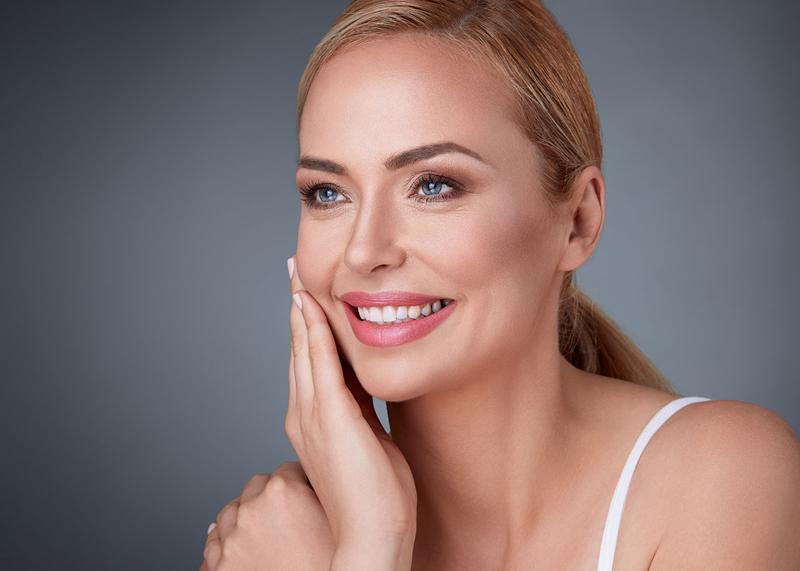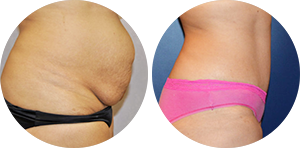Buccal Fat Removal
Offered at our convenient location in Raleigh, NC
Hop on the Latest Beauty Trend!

Buccal Fat Pad (BFP) removal is a popular cosmetic surgery that involves removing a part of the fat from the cheeks’ buccal fat pads. These fatty pockets sit between the cheekbones and the lower jawline creating a “baby face” or a “round face” appearance, which can be undesirable for some people. Buccal fat removal is often more popular among younger individuals looking to achieve a more youthful and contoured face – without makeup!
If you’re considering buccal fat removal, it’s important to choose a qualified and experienced surgeon to perform the procedure. One such surgeon is Dr. Amber L Allen of Allen Aesthetic Surgery in Raleigh, NC. Dr. Allen is double-board certified in cosmetic and general surgery, which gives her a deep knowledge of facial aesthetics. She has extensive experience performing buccal fat removal procedures and has helped many patients achieve their desired facial contouring goals. To learn more about buccal fat removal or other cosmetic procedures, contact Allen Aesthetic Surgery at (919) 676-5052 to schedule a consultation.
Dr. Allen’s blog offers patients a peek behind the curtain for their favorite – or future favorite! – procedures and treatments. Check it out!
Contents
- 1 Hop on the Latest Beauty Trend!
- 2 About Buccal Fat Removal
- 3 What are the Benefits of Buccal Fat Removal?
- 4 Who is the Ideal Candidate for Bucal Fat Pad Removal?
- 5 Personal Consultation
- 6 Preparation
- 7 The Surgery
- 8 Recovery After Buccal Fat Removal
- 9 What are the Results of Buccal Fat Removal in Raleigh?
- 10 Corresponding & Complementary Procedures
- 11 What is the Cost of Buccal Fat Removal Raleigh, NC
- 12 References
About Buccal Fat Removal
Bichat’s ball, also known as the buccal fat pad, is named after its discoverer, French anatomist Xavier Bichat. Bichat first described the buccal fat pad in the early 19th century. [1] Although the buccal fat pad has several functions, including cushioning the chewing muscles and providing structural support to the cheeks, it is most well-known for its aesthetic role in facial fullness.
Today, the buccal fat pad has become a focus of interest in plastic surgery, particularly for those seeking to achieve a more defined and sculpted facial appearance through buccal fat removal. The buccal fat pad grows from childhood to adulthood and then decreases in size between ages 20 and 50. [2]
Just above the buccal fat are cheekbones, also known as malar bones. The cheekbones are a prominent feature of the face and play an important role in our overall facial appearance. Having well-defined cheekbones is highly desirable as they can make the face appear slimmer and more youthful. They are associated with models, regality, and sex-appeal, so it’s no wonder buccal fat removal is sweeping through social media.
Over-removal of the buccal fat pad can lead to an unnatural, gaunt look in patients who do not have well-defined cheekbones to support the face. This is why it is essential to consult with a board-certified surgeon who can assess your facial anatomy and recommend the appropriate treatment plan to achieve your desired results. With the right surgical approach, buccal fat pad removal can be a safe and effective way to achieve a more sculpted, youthful facial appearance.
What are the Benefits of Buccal Fat Removal?
Some benefits of buccal fat removal include enhanced facial definition and contouring, the ability to achieve a more chiseled and angular appearance, and an overall more aesthetically pleasing look. In addition, patients often report feeling more confident and satisfied with their appearance after the procedure. Buccal fat removal can also provide long-lasting results, as the fat cells do not regenerate after being removed.
Not only can buccal fat removal enhance the contours of the face, but it can also change your makeup game. With a more defined and contoured facial structure, you can create a more dramatic and striking look with makeup. And with a more youthful appearance in your cheeks, you may find that you no longer need to contour or highlight your cheeks as heavily.
Buccal fat removal is a relatively quick and straightforward procedure that can be performed under local anesthesia on an outpatient basis. Recovery time is typically minimal, with most patients returning to their normal activities within a few days making this a highly desirable procedure.
Who is the Ideal Candidate for Bucal Fat Pad Removal?
Babies often have the plumpest buccal fat pads – those pinchable cherub cheeks. It is a sign of youth, but patients who are moving beyond their early years into young adulthood may find that their buccal fat pads make them appear heavier and less defined in the mid-face.
The ideal candidate for buccal fat pad removal surgery is someone who has prominent cheeks that hide their strong cheekbones, creating the appearance of a heavy and excessively round face. The procedure is not recommended for patients with hypoplastic malar bones because it can lead to unfavorable results due to overcorrection. [3]
Personal Consultation
Dr. Allen is a highly skilled and experienced surgeon who specializes in buccal fat pad removal. She understands that each patient’s needs are unique and works closely with them to determine the best treatment plan for their individual goals.
During a personal consultation with Dr. Allen, patients can expect a thorough evaluation of their facial structure and discussion of their desired outcomes. Dr. Allen will explain the buccal fat removal procedure in detail, and answer any questions or concerns the patient may have. If Dr. Allen feels another procedure might better suit the patient, or complement the procedure, she will provide personalized recommendations. Dr. Allen strives to ensure that each patient feels comfortable and confident throughout the entire process, from initial consultation to post-operative follow-up. Call (919) 676-5052 to schedule your consultation.
Preparation
Dr. Allen will provide you with detailed instructions on what you need to do to prepare for surgery. You may be asked to avoid certain medications, vitamins, and supplements that can increase the risk of bleeding. You will also need to stop smoking and consuming alcohol for a specified period before and after surgery, as these can also increase the risk of complications.
The Surgery
Buccal fat removal is typically performed under local anesthesia, with patients being awake throughout the procedure. During the surgery, a small incision is made on the inside of the cheek, and Dr. Allen will then carefully remove the small fat pockets from the cheeks.
The BFP is comprised of three parts, with the posterior part having four extensions. The body and buccal extension are the parts of the BFP that are typically removed during the surgery for midfacial contouring. These two parts can constitute up to 70% of the total volume of the buccal pad.
Once the necessary amount of fat has been removed, the incision is then closed with dissolvable sutures. The procedure does not carry a risk of visible scarring.
Recovery After Buccal Fat Removal
Recovery from buccal fat pad surgery typically involves some swelling, bruising, and discomfort in the cheeks, which can last for several days or weeks. Patients are advised to rest, avoid strenuous activity, and follow a soft diet for a few days after the procedure.
Here are some general guidelines on what to eat and drink after surgery:
- Drink plenty of water and other fluids like fruit juice, coconut water, or electrolyte drinks to help your body recover and prevent dehydration.
- In the first few days after surgery, eat soft, easy-to-digest foods such as soups, mashed potatoes, scrambled eggs, smoothies, and yogurt. Avoid hard, crunchy, or spicy foods that may irritate the surgical site.
- Using a straw can create negative pressure in the mouth and dislodge any blood clots or stitches, which can delay the healing process. Instead, sip liquids slowly from a cup or glass.
- If you do eat solid foods, chew carefully and avoid biting down directly on the surgical site. Cut your food into small pieces and chew with your front teeth.
Every patient is different, and your dietary needs may vary. Consult with Dr. Allen for specific dietary recommendations.
What are the Results of Buccal Fat Removal in Raleigh?

The removal of excess fat in the cheeks can create a more contoured, angular look, highlighting the natural bone structure of the face. After the procedure, patients typically notice a reduction in the fullness of their cheeks, resulting in a slimmer, more defined appearance. The jawline may also appear more defined, enhancing the overall shape of the face.
Patients who undergo the procedure often report feeling more confident and satisfied with their facial appearance, as the procedure can create a more harmonious balance between the features of the face.
Corresponding & Complementary Procedures
Various cosmetic procedures, including dermal fillers, can further enhance cheekbones. These procedures help create a more defined and sculpted appearance, enhancing the buccal fat pad removal and highlighting the face’s youthful beauty.
In cases where extensive associated procedures such as submental liposuction or blepharoplasty are performed alongside buccal fat pad removal, general anesthesia may be preferred. This is because the combination of procedures can require a longer operating time and may cause discomfort for the patient if done under local anesthesia alone. When multiple procedures are performed together, patients may enjoy a more comprehensive transformation and a more harmonious overall appearance.
Buccal Fat Pad Removal For Older Patients
As the buccal fat pad naturally decreases in volume with age, its removal can make low-lying jowls more apparent and contribute to facial deformations commonly associated with aging. As a result, procedures like autologous fat grafts may complement this rejuvenation of the face.
What is the Cost of Buccal Fat Removal Raleigh, NC
The cost of the procedure typically includes several fees, including the surgeon’s fee, anesthesia fee, facility fee, and other related expenses. Dr. Allen looks forward to discussing the cost and other important aspects of the procedure during your consultation. Call (919) 676-5052 to schedule yours today!
References
- Shoja MM, Tubbs RS, Loukas M, Shokouhi G, Ardalan MR. Marie-François Xavier Bichat (1771-1802) and his contributions to the foundations of pathological anatomy and modern medicine. Annals of Anatomy = Anatomischer Anzeiger: Official Organ of the Anatomische Gesellschaft. 2008;190(5):413-420. https://doi.org/10.1016/j.aanat.2008.07.004
- Jackson, Ian T. M.D.. Anatomy of the Buccal Fat Pad and Its Clinical Significance. Plastic and Reconstructive Surgery 103(7):p 2059-2060, June 1999. https://journals.lww.com/plasreconsurg/Citation/1999/06000/Anatomy_of_the_Buccal_Fat_Pad_and_Its_Clinical.42.aspx
- 479.Hypoplasia of the zygomatic bone (Concept Id: C4021242) – MedGen – NCBI. www.ncbi.nlm.nih.gov. Accessed May 3, 2023. https://www.ncbi.nlm.nih.gov/medgen/866886


